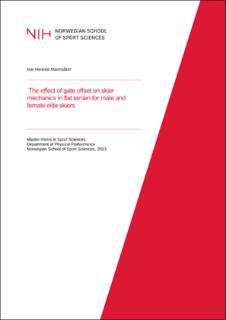| dc.description.abstract | Purpose: The purpose of this study was to investigate the effects increasing the offset of gates in giant slalom on injury risk of World Cup skiers. Injury risk factors has been used as surrogate parameters for injury risk.
Method: Data was collected in Kvitfjell during a training camp of the Norwegian national ski team. Three male and 2 female World Cup skiers participated in he study. An open rhythmic course was set by one of the coaches on a slope with an average incline of 13 degrees. The course had an average gate distance of 27.0m and an offset of 6.6m (Course 1)1. Two sections of 5 gates was then adjusted by increasing the offset by 1.0m (Course 2) and then by 1.5m (Course 3). Participants skied 3 runs in each course. Terrain and course-set were measured using dGNSS. Athletes carried a dGNSS and inertial navigation system from which speed, ground reaction force, turn radius and impulse (the ground reaction force over time) were calculated.
Results: In course 2 and 3, where offset was increased by 1.0m and 1.5m respectively compared to Course 1, speed was reduced. Each additional gate with increased offset led to and additional reduction in speed. In the first course intervention section the results were most homogenous. Here Course 2, where offset was increased by 1.0m, caused a speed reduction per turn with increased offset of about 0.6km/h compared to course 1. In course 3, where the offset was increased by 1.5m, the speed reduction was about 0.9 km/h for both sexes. Hence the course-set intervention had similar effects on women and men in absolute and relative terms. Increased gate offset in the flat terrain did not lead to any increase in maximal ground reaction forces or decrease in minimal turn radius. The impulse and physical load on the athletes was increased with increasing gate offset.
Conclusion: In flat terrain the main consequence of increased gate offset are speed reduction and an increased physical load. Minimal turn radius and maximal ground reaction force were not changed. Course-setters need to consider the trade-off between speed control and physical fatigue when setting courses in flat terrain. | en_US |
